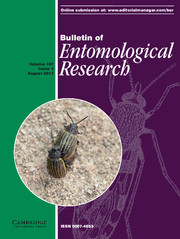Ver ítem
- xmlui.general.dspace_homeCentros e Institutos de InvestigaciónCICVyA. Centro de Investigación en Ciencias Veterinarias y AgronómicasInstituto de GenéticaArtículos científicosxmlui.ArtifactBrowser.ItemViewer.trail
- Inicio
- Centros e Institutos de Investigación
- CICVyA. Centro de Investigación en Ciencias Veterinarias y Agronómicas
- Instituto de Genética
- Artículos científicos
- Ver ítem
Effects of superparasitism on immature and adult stages of Diachasmimorpha longicaudata Ashmead (Hymenoptera: Braconidae) reared on Ceratitis capitata Wiedemann (Diptera: Tephritidae)
Resumen
The optimal use of available host by parasitoid insects should be favoured by natural selection. For solitary parasitoids, superparasitism (i.e. the egg-laying of several eggs/host) may represent a detrimental phenomenon both in a biological and an applied sense, but under certain circumstances it may be adaptive. Here, we studied the effects of increasing levels of superparasitism (LSPs, number of parasitoid larvae/host) on fitness-related parameters of
[ver mas...]
The optimal use of available host by parasitoid insects should be favoured by natural selection. For solitary parasitoids, superparasitism (i.e. the egg-laying of several eggs/host) may represent a detrimental phenomenon both in a biological and an applied sense, but under certain circumstances it may be adaptive. Here, we studied the effects of increasing levels of superparasitism (LSPs, number of parasitoid larvae/host) on fitness-related parameters of the immature and adult stages of Diachasmimorpha longicaudata, a solitary endoparasitoid parasitizing Ceratitis capitata. We investigated the moment when supernumerary parasitoid larvae are eliminated and the effects produced by this process, together with its repercussion on female fecundity, parasitism rate, sex ratio, adult survival, flight ability and body size. Complete elimination of competitors occurred soon after larval hatching, before reaching the second larval stage. Elimination process took longer at higher LSPs, although a normal developmental (egg–adult) time was achieved. For LSPs 1, 2, 3 and 5 the effects on parasitoid emergence were mild, but LSP 10 led to the death of all developing parasitoids. Aside from this, to develop in superparasitized hosts did not significantly affect any of the evaluated parameters, and only a female-biased sex ratio was observed at higher LSPs. However, the effects of superparasitism on the adults may have a different outcome under more variable conditions in the field, once they are released for biological control purposes.
[Cerrar]

Fuente
Bulletin of entomological research 107(6) : 756-767. (2017 Dec)
Fecha
2017
ISSN
0007-4853 (Print)
1475-2670 (Online)
1475-2670 (Online)
Formato
pdf
Tipo de documento
artículo
Palabras Claves
Derechos de acceso
Restringido
 Excepto donde se diga explicitamente, este item se publica bajo la siguiente descripción: Creative Commons Attribution-NonCommercial-ShareAlike 2.5 Unported (CC BY-NC-SA 2.5)
Excepto donde se diga explicitamente, este item se publica bajo la siguiente descripción: Creative Commons Attribution-NonCommercial-ShareAlike 2.5 Unported (CC BY-NC-SA 2.5)

